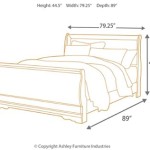When Can Baby Change to Toddler Bed?
The transition from crib to toddler bed is a significant milestone in a child's development. It signifies their growing independence and a shift in their sleeping arrangements. While there's no set age for this change, it's generally recommended when the child demonstrates readiness through physical and developmental milestones. This article explores the factors to consider when determining if a child is ready for a toddler bed and provides practical tips for making the transition smoother.
Physical Readiness
A key indicator of readiness for a toddler bed is physical ability. Children who have developed enough motor skills to climb in and out of the bed safely are often ready for the transition. However, remember that each child develops at their own pace. Consider these factors:
- Climbing Skills: Can your child easily climb into and out of the bed without assistance? Look for confidence and agility in their movements.
- Height: Is your child tall enough that the toddler bed won't present a risk of falling? A general guideline is when they reach at least 34 inches tall.
- Coordination: Can your child move around safely in their sleep without bumping into furniture or falling out of bed? Increased coordination indicates a lower risk of accidents.
It's important to note that physical readiness doesn't always guarantee success. Some children may be physically capable but may not be emotionally ready for the change, leading to sleep disruptions or anxieties.
Developmental Readiness
Beyond physical capabilities, developmental readiness plays a crucial role in a smooth transition. Children who are ready for a toddler bed often exhibit specific developmental milestones and behaviors. Consider the following:
- Understanding of Boundaries: Can your child understand and follow simple instructions regarding staying in their bed? Do they understand the difference between bedtime and playtime?
- Socialization: Has your child started showing interest in sleeping in a "big kid" bed? Are they imitating older siblings or friends who sleep in toddler beds?
- Sleep Patterns: Has your child established a consistent sleep schedule? Do they regularly wake up during the night for reasons other than hunger or illness?
These indicators suggest that the child is mentally ready to understand the concept of a bed as a safe and comfortable place for sleep. Observing these cues can offer insights into their readiness for a transition.
Choosing the Right Time
While physical and developmental readiness are crucial, choosing the right time for the transition is equally important. It's best to avoid making the change during stressful periods, such as:
- Major Life Changes: Moving to a new house, starting daycare or preschool, or welcoming a new sibling can be overwhelming for a child.
- Illness or Recovery: Avoid shifting sleeping arrangements when your child is sick or recovering from an illness. Focus on providing comfort and stability.
- Travel: Long trips or overnight stays can disrupt sleep patterns. It's best to postpone the transition until after the travel is complete.
Choosing a time when the family is relaxed and settled can minimize disruption and make the transition smoother for everyone involved.
Practical Tips for a Smooth Transition
Once you've determined that your child is ready for a toddler bed, here are some practical tips to help the transition go smoothly:
- Introduce the Bed Gradually: Don't expect an immediate switch. Start by letting your child explore the bed while you're present. Gradually increase time spent in the bed until they're comfortable sleeping in it.
- Create a Welcoming Environment: Make the toddler bed inviting for your child. Decorate it with their favorite characters, bedding, and toys. This can make it more appealing and familiar.
- Maintain Consistency: Establish a consistent bedtime routine and stick to it as much as possible. This reinforces the expectation of sleeping in the new bed.
- Address Fears: If your child shows signs of anxiety or fear, address them with patience and reassurance. Talk about the bed and its benefits in a calm and positive manner.
- Offer Alternatives: Provide comfort objects or transitions that are familiar to your child, such as a favorite stuffed animal or blanket. This can help ease the transition and provide a sense of security.
Remember that patience and consistency are essential for a successful transition. Encourage your child's independence and celebrate their milestones as they adjust to their new bed.

How To Move Your Child From Crib Toddler Bed Safely

Transitioning From Crib To Toddler Bed

Time For A Big Kid Bed When And How To Transition From Crib Todd Dadada Baby

10 Best Tips For Transitioning From Crib To Bed Busy Toddler

Ultimate Guide To The Toddler Bed Transition Taking Cara Babies

Signs Your Child Is Ready For A Toddler Bed And Tips On How To Make The Switch Socal Mommy Life

When To Transition Toddler Bed And How Cleveland Clinic

Transition From Crib To Toddler Bed Happiest Baby

When To Transition Toddler Bed Signs Your Child Is Ready

When Should You Switch Your Toddler To A Bed Baby Earth
Related Posts







